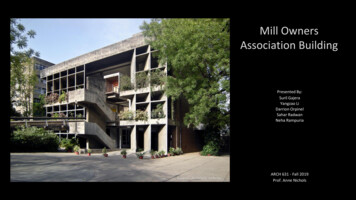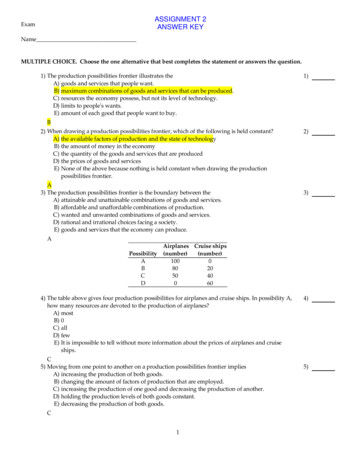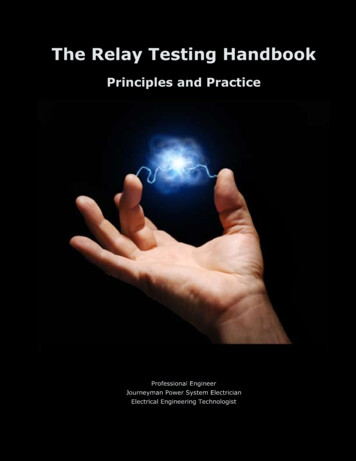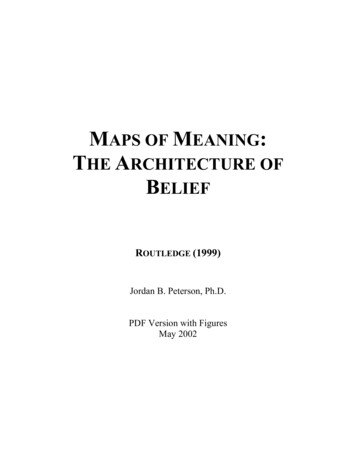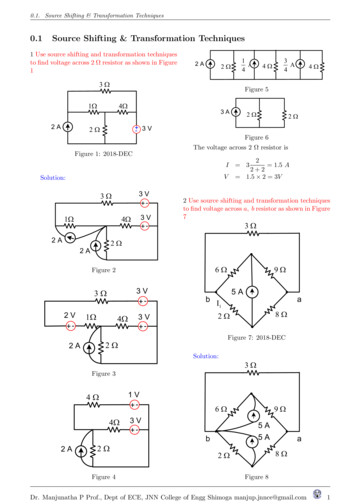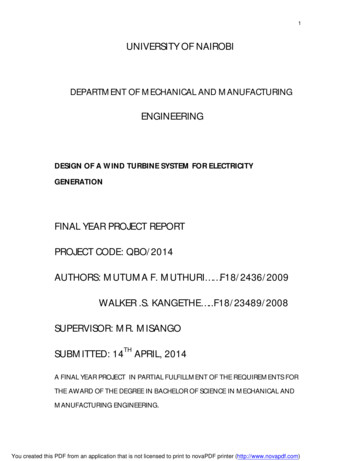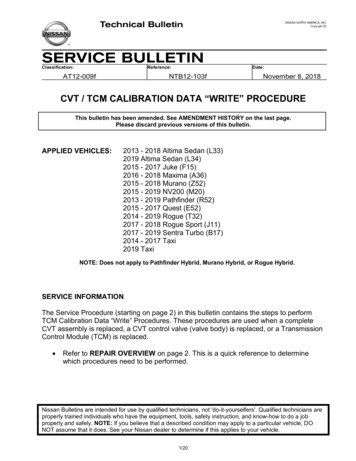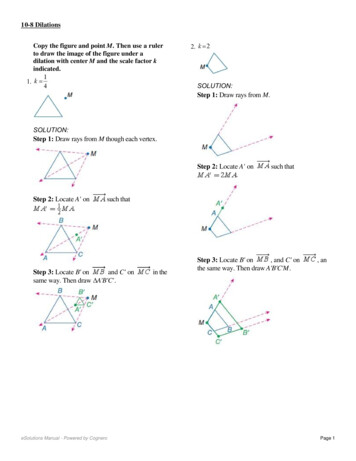
Transcription
10-8 DilationsCopy the figure and point M. Then use a rulerto draw the image of the figure under adilation with center M and the scale factor kindicated.1.2.SOLUTION:Step 1: Draw rays from M.SOLUTION:Step 1: Draw rays from M though each vertex.Step 2: Locate A' on.Step 2: Locate A' on.such thatsuch thatStep 3: Locate B' onand C' onsame way. Then draw ΔA'B'C'.in theStep 3: Locate B' on, and C' onthe same way. Then draw A'B'C'M., an3. Determine whether the dilation from Figure B tois an enlargement or a reduction. Then find thescale factor of the dilation and x.2.SOLUTION:Step 1: Draw rays from M.eSolutions Manual - Powered by CogneroPage 1SOLUTION:
SOLUTION:250 ; The organism’s length in millimeters is 200 1000 or 0.2 mm.10-8 DilationsThe scale factor of the dilation is3. Determine whether the dilation from Figure B tois an enlargement or a reduction. Then find thescale factor of the dilation and x.or 250.Graph the image of each polygon with the givenvertices after a dilation centered at the originwith the given scale factor.5. W(0, 0), X(6, 6), Y(6, 0); k 1.5SOLUTION:Multiply the x- and y-coordinates of each vertex bythe scale factor k.Multiply the x- and y- coordinates by 1.5.SOLUTION:The figureis larger than the figure B, so thedilation an enlargement.The scale factor is.The value of x is 8 – 6 or 2.4. BIOLOGY Under a microscope, a single-celledorganism 200 microns in length appears to be 50millimeters long. If 1 millimeter 1000 microns, whatmagnification setting (scale factor) was used?Explain your reasoning.6. Q(–4, 4), R(–4, –4), S(4, –4), T(4, 4); k SOLUTION:250 ; The organism’s length in millimeters is 200 1000 or 0.2 mm.The scale factor of the dilation isSOLUTION:Multiply the x- and y-coordinates of each vertex bythe scale factor k.Multiply the x- and y-coordinates by 1/2.or 250.Graph the image of each polygon with the givenvertices after a dilation centered at the originwith the given scale factor.5. W(0, 0), X(6, 6), Y(6, 0); k 1.5SOLUTION:Multiply the x- and y-coordinates of each vertex bythe scale factor k.Multiply the x- and y- coordinates by 1.5.eSolutions Manual - Powered by Cognero7. A(–1, 4), B(2, 4), C(3, 2), D(–2, 2); k 2SOLUTION:Multiply the x- and y-coordinates of each vertexPageby 2the scale factor k.
10-8 Dilations7. A(–1, 4), B(2, 4), C(3, 2), D(–2, 2); k 2SOLUTION:Multiply the x- and y-coordinates of each vertex bythe scale factor k.Multiply the x- and y- coordinates by 2.CCSS TOOLS Copy the figure and point S.Then use a ruler to draw the image of the figureunder a dilation with center S and the scalefactor k indicated.9.SOLUTION:Step 1: Draw rays from S though each vertex.Step 2: Locate A' onsuch thatStep 3: Locate B' on, C' on.8. J(–2, 0), K(2, 4), L(8, 0), M (2, –4); k SOLUTION:Multiply the x- and y-coordinates of each vertex bythe scale factor k.Multiply the x- and y-coordinates by the scale factor3/4., and D' onin the same way. Then draw A'B'C'D'.CCSS TOOLS Copy the figure and point S.Then use a ruler to draw the image of the figureunder a dilation with center S and the scalefactor k indicated.10. k 39.eSolutions Manual - Powered by CogneroPage 3SOLUTION:
Step 3: Locate B' on10-8 Dilations, C' on,and D' onin the same way. Then draw A'B'C'D'.10. k 3SOLUTION:Step 1: Draw rays from S though each vertex.Step 2: Locate A' onsuch that.11. k 0.8SOLUTION:Step 1: Draw rays from S though each vertex.Step 3: Locate B' on, C' onStep 2: Locate A' on.such thatStep 3: Locate B' on, C' on,and D' onin the same way. Then draw A'B'C'D'., and D' onin the same way. Then draw A'B'C'D'.eSolutions Manual - Powered by CogneroPage 412.
10-8 Dilations11. k 0.812.SOLUTION:SOLUTION:Step 1: Draw rays from S though each vertex.Step 1: Draw rays from S though each vertex.Step 2: Locate A' on.Step 3: Locate B' onsuch that, C' on, and D' onStep 2: Locate A'onsuch thatStep 3: Locate B' on, C' on.,and D' onin the same way. Then draw A'B'C'D'.in the same way. Then draw A'B'C'D'.13. k 2.2512.SOLUTION:Step 1: Draw rays from S though each vertex.SOLUTION:Step 1: Draw rays from S though each vertex.eSolutions Manual - Powered by CogneroStep 2: Locate A'onsuch that.Step 2: Locate A' on.such thatPage 5
10-8 Dilations13. k 2.2514.SOLUTION:Step 1: Draw rays from S though each vertex.SOLUTION:Step 1: Draw rays from S though each vertex.Step 2: Locate A' on.such thatStep 2: Locate A' onStep 3: Locate B' ondraw ΔA'B'S.such that.in the same way. ThenStep 3: Locate B' onand C' onsame way. Then draw A'B'C'S.in the14.Determine whether the dilation from figure Wtois an enlargement or a reduction. Thenfind the scale factor of the dilation and x.SOLUTION:Step 1: Draw rays from S though each vertex.15.eSolutions Manual - Powered by CogneroSOLUTION:The figurePage 6is larger than the figure W, so the
The figureis larger than the figure W, so thedilation an enlargement.The value of x is 10 – 4 or 6.10-8 DilationsThe scale factor is.Determine whether the dilation from figure Wtois an enlargement or a reduction. Thenfind the scale factor of the dilation and x.17.SOLUTION:The figureis smaller than the figure W, so thedilation a reduction.15.SOLUTION:The scale factor isThe figureis larger than the figure W, so thedilation an enlargement.The value of x is 9 – 4.5 or 4.5.The scale factor is.The value of x is 14 – 10.5 or 3.5.18.SOLUTION:The figureis smaller than the figure W, so thedilation a reduction.The value of x is 12 – 8 or 4.16.SOLUTION:The figureis larger than the figure W, so thedilation an enlargement.The value of x is 10 – 4 or 6.The scale factor is.The scale factor is.INSECTS When viewed under a microscope,each insect has the measurement given onthe picture. Given the actual measure of eachinsect, what magnification was used?Explain your reasoning.19. Refer to the photo on page 664.SOLUTION:15 ; The insect’s image length in millimeters is 3.75 10 or 37.5 mm.The scale factor of the dilation is17.or 15.SOLUTION:The figureis smaller than the figure W, so thedilation a reduction.The scale factor is.The value of x is 14 – 10.5 or 3.5.eSolutions Manual - Powered by Cognero20. Refer to the photo on page 664.SOLUTION:96 ; The insect’s image length in millimeters is 4.8 ·10 or 48 mm.The scale factor of the dilation isor 96.Page 7CCSS SENSE-MAKING Find the image of each
15 ; The insect’s image length in millimeters is 3.75 10 or 37.5 mm.scale factor of the dilation is10-8TheDilationsor 15.20. Refer to the photo on page 664.22. S(0, 0), T(–4, 0), V(–8, –8); k 1.25SOLUTION:96 ; The insect’s image length in millimeters is 4.8 ·10 or 48 mm.The scale factor of the dilation isor 96.SOLUTION:Multiply the x- and y-coordinates of each vertex bythe scale factor k. That is,.Here multiply the x- and y- coordinates by the scalefactor 1.25.CCSS SENSE-MAKING Find the image of eachpolygon with the given vertices after a dilationcentered at the origin with the given scalefactor.21. J(–8, 0), K(–4, 4), L(–2, 0); k 0.5SOLUTION:Multiply the x- and y-coordinates of each vertex bythe scale factor k. That is,.Here multiply the x- and y- coordinates by the scalefactor 0.5.23. A(9, 9), B(3, 3), C(6, 0); k SOLUTION:Multiply the x- and y-coordinates of each vertex bythe scale factor k. That is,.Here multiply the x- and y- coordinates by the scalefactor 1/3.22. S(0, 0), T(–4, 0), V(–8, –8); k 1.25SOLUTION:Multiply the x- and y-coordinates of each vertex bythe scale factor k. That is,.Here multiply the x- and y- coordinates by the scalefactor 1.25.24. D(4, 4), F(0, 0), G(8, 0); k 0.75SOLUTION:Multiply the x- and y-coordinates of each vertex bythe scale factor k. That is,.Here multiply the x- and y- coordinates by the scalefactor 0.75.eSolutions Manual - Powered by Cognero23. A(9, 9), B(3, 3), C(6, 0); k Page 8
10-8 Dilations24. D(4, 4), F(0, 0), G(8, 0); k 0.75SOLUTION:Multiply the x- and y-coordinates of each vertex bythe scale factor k. That is,.Here multiply the x- and y- coordinates by the scalefactor 0.75.26. W(2, 2), X(2, 0), Y(0, 1), Z(1, 2); k 3SOLUTION:Multiply the x- and y-coordinates of each vertex bythe scale factor k. That is,.Here multiply the x- and y-coordinates by the scalefactor 3.25. M (–2, 0), P(0, 2), Q(2, 0), R(0, –2); k 2.5SOLUTION:Multiply the x- and y-coordinates of each vertex bythe scale factor k. That is,.Here multiply the x- and y-coordinates by the scalefactor 2.5.27. COORDINATE GEOMETRY Refer to the graphof FGHJ.a. Dilate FGHJ by a scale factor ofcentered atthe origin, and then reflect the dilated image in the yaxis.b. Complete the composition of transformations inpart a in reverse order.c. Does the order of the transformations affect thefinal image?d. Will the order of a composition of a dilation and areflection sometimes, always, or never affect thedilated image? Explain your reasoning.26. W(2, 2), X(2, 0), Y(0, 1), Z(1, 2); k 3SOLUTION:Multiply the x- and y-coordinates of each vertex bythe scale factor k. That is,.Here multiply the x- and y-coordinates by the scalefactor 3.eSolutions Manual - Powered by CogneroSOLUTION:a. Multiply the x- and y-coordinates of each vertexby the scale factor .Page 9
SOLUTION:a. Multiply the x- and y-coordinates of each vertex10-8 Dilationsby the scale factor .Then dilate the image by a scale factor of .Reflect in the y -axis.c. No; the coordinates of the final image are thesame regardless of which transformation was donefirst.Then graph the image and the transformed image.d. Sometimes; sample answer: for the order of acomposition of a dilation and a reflection to beunimportant, the dilation must be about the origin or apoint on the line of reflection and the line of reflectionmust contain the origin, or must be of the form y mx.28. PHOTOGRAPHY AND ART To make a griddrawing in the style of Chuck Close, students overlayab. First reflect the image in the y -axis.Then dilate the image by a scale factor of .-inch grid on a 5-inch by 7-inch high contrastphoto, overlay a–inch grid on a 10-inch by 14-inch piece of drawing paper, and then sketch theimage in each square of the photo to thecorresponding square on the drawing paper.a. What is the scale factor of the dilation?b. To create an image that is 10 times as large as theoriginal, what size grids are needed?c. What would be the area of a grid drawing of a 5inch by 7-inch photo that used 2-inch grids?SOLUTION:a. Students overlay a-inch grid on a 5-inch by 7-inch high contrast photo and overlay aeSolutions Manual - Powered by Cognero-inch gridon a 10-inch by 14-inch piece of drawing paper.Page 10The drawing paper is twice the contrast photo.Therefore, the scale factor is 2:1.
composition of a dilation and a reflection to beunimportant, the dilation must be about the origin or apoint on the line of reflection and the line of reflection10-8mustDilationscontain the origin, or must be of the form y mx.inch by (7)(8) or 56-inch.To find the area of the grid drawing multiply thelength times the width.(40)(56) 224028. PHOTOGRAPHY AND ART To make a griddrawing in the style of Chuck Close, students overlay29. MEASUREMENT Determine whether the imageshown is a dilation of ABCD. Explain your reasoning.a2Therefore, the area is 2240 in .-inch grid on a 5-inch by 7-inch high contrastphoto, overlay a–inch grid on a 10-inch by 14-inch piece of drawing paper, and then sketch theimage in each square of the photo to thecorresponding square on the drawing paper.a. What is the scale factor of the dilation?b. To create an image that is 10 times as large as theoriginal, what size grids are needed?c. What would be the area of a grid drawing of a 5inch by 7-inch photo that used 2-inch grids?SOLUTION:a. Students overlay a-inch grid on a 5-inch by 7-inch high contrast photo and overlay a-inch gridon a 10-inch by 14-inch piece of drawing paper.The drawing paper is twice the contrast photo.Therefore, the scale factor is 2:1.b. The original size of the grid isSOLUTION:For the two rectangles to be similar, the ratios of thelengths of each side of the image to that of theoriginal should be the same. Use a ruler to measurethe long side of the image and.Next, compare the lengths of the short side of theimage and.-inch. To make itto 10 times larger, multiply by 10.Since the measures of the sides of the rectangles arenot proportional, so they are not similar and cannot bea dilation.They need 2.5 inch grid.c. When they use 2-inch grid that would be 8 timeslarger than the original photo.The dimension of the photo would be (5)(8) or 40inch by (7)(8) or 56-inch.To find the area of the grid drawing multiply thelength times the width.(40)(56) 224030. COORDINATE GEOMETRY WXYZ has verticesW(6, 2), X(3, 7), Y( 1, 4), and Z(4, 2).a. Graph WXYZ and find the perimeter of the figure.Round to the nearest tenth.b. Graph the image of WXYZ after a dilation ofcentered at the origin.2Therefore, the area is 2240 in .29. MEASUREMENT Determine whether the imageshown is a dilation of ABCD. Explain your reasoning.c. Find the perimeter of the dilated image. Round tothe nearest tenth. How is the perimeter of the dilatedimage related to the perimeter ofWXYZ?SOLUTION:a. Graph WXYZ.eSolutions Manual - Powered by CogneroSOLUTION:Page 11
image related to the perimeter ofWXYZ?1/2.SOLUTION:10-8 Dilationsa. Graph WXYZ.Use the distance formula to find the distancebetween each vertex.c. Use the distance formula to find the distancebetween each vertex.The perimeter of the figure is 23.1.b. Multiply the x- and y-coordinates of each vertexby the scale factor k.Multiply the x- and y-coordinates by the scale factor1/2.eSolutions Manual - Powered by CogneroThe perimeter of the dilated figure is 11.6.The perimeter of the dilated figure is half of theperimeter of WXYZ.31. CHANGING DIMENSIONS A three-dimensionalfigure can also undergo a dilation. Consider therectangular prism shown.a. Find the surface area and volume of the prism.b. Find the surface area and volume of the prismafter a dilation with a scale factor of 2.Page 12c. Find the surface area and volume of the prismafter a dilation with a scale factor of.
times of the volume of the originalimage.The surface area of the dilated figure would be10-8 Dilationsa. Find the surface area and volume of the prism.b. Find the surface area and volume of the prismafter a dilation with a scale factor of 2.c. Find the surface area and volume of the prismafter a dilation with a scale factor of2cm .The volume of the dilated figure would be3cm .d. How many times as great is the surface area andvolume of the image as the preimage after eachdilation?e . Make a conjecture as to the effect a dilation witha positive scale factor r would have on the surfacearea and volume of a prism.d. surface area:SOLUTION:a. The surface area of a rectangular prism is givenby S 2(lb bh hl), where l is the length, b is thebase, and h is the height.Substitute 6 for l, 2 for w, and 4 for h in the formula.with scale factor 2;2surface area of preimage: 88 cm2surface area of image with scale factor 2: 352 cm2or (88 4) cmThe surface area is 4 times greater after dilationscale factoras great after dilation with.volume:3volume of preimage: 48 cm32The surface area of the rectangular prism is 88 cm .The volume of a rectangular prism is given by V lbh.Substitute.3The volume of the rectangular prism is 48 cm .b. When the figure is dilated by a scale factor 2, thesurface area and the volume of the dilated figure will23be 2 or 4 times of the surface area and 2 or 8 timesof the volume of the original image.The surface area of the dilated figure would be2cm .The volume of the dilated figure would be3cm .c. When the figure is dilated by a scale factor, thesurface area and the volume of the dilated figure willbetimes of the surface area andtimes of the volume of the originalimage.The surface area of the dilated figure would be2cm .The volume of the dilated figure would beeSolutions Manual - Powered by Cognero3cm .volume of image with scale factor 2: 384 cm or3cmThe volume is 8 times greater after dilation withscale factor 2;factoras great after dilation with scale.e . From part d, when a scale factor of 2 is applied,the surface area of the preimage would be multipliedby 4. When a scale factor of 1/2 is applied, thesurface area of the preimage would be multiplied by1/4. So, if a positive scale factor r is applied, thesurface area of the preimage would be multiplied by2r . For volume, when the scale factor 2 was applied,the volume of the image was 8 times the volume ofthe preimage. When the scale factor was 1/2, thevolume of the image was 1/8 times the volume of thepreimage. So, when a scale factor of r is applied, the3volume of the preimage would be multiplied by r .32. CCSS PERSEVERANCE Refer to the graph of.a. Graph the dilation ofcentered at point Dwith a scale factor of 3.b. Describe the dilation as a composition oftransformations including a dilation with a scalefactor of 3 centered at the origin.c. If a figure is dilated by a scale factor of 3 with acenter of dilation (x, y), what composition oftransformations, including a dilation with a scalefactor of 3 centered at the origin, will produce thePage 13same.
b. Describe the dilation as a composition oftransformations including a dilation with a scalefactor of 3 centered at the origin.If a figure is dilated by a scale factor of 3 with a10-8c.Dilationscenter of dilation (x, y), what composition oftransformations, including a dilation with a scalefactor of 3 centered at the origin, will produce thesame.SOLUTION:a. The point D is the center of dilation. The distancebetween the points D and E is 2 units. So, make it 3times larger.To dilate the point F from D, first extent the verticaldistance of 2 units by 3 times and then extent thehorizontal distance of 2 units by 3 times.and its image.Now drawNext, compare this image with the image in part a. Ifthis image is translated 4 units down and 2 units tothe left, it will coincide with the image in part a. So,the composition of a dilation with scale factor 3centered at the origin and a translation alongis equivalent to a dilation with scalefactor 3 centered at point D.c. In part a, the center of dilation is at D(1, 2). Frompart b, when x 1 and y 2, the translation vector is -2, -4 . Next, determine the translation vector interms of x and y. The translation vector -2x, -2y yields -2(1), -2(2) or -2, -4 when (x, y) (1, 2)is substituted.The composition of a dilation with a scale factor of 3centered at the origin and a translation along.33. HEALTH A coronary artery may be dilated with aballoon catheter as shown. The cross section of themiddle of the balloon is a circle.a. A surgeon inflates a balloon catheter in a patient’scoronary artery, dilating the balloon as shown. Findthe scale factor of this dilation.b. Find the cross-sectional area of the balloon beforeand after the dilation.b. First, graph triangle DEF and the image dilated bya scale factor of 3 centered at the origin.(x, y) (3x, 3y)D(1, 2) D'(3, 6)E(3, 2) E'(9, 6)F(3, 0) F'(9, 0)SOLUTION:a. The second balloon is larger than the first balloon,so the dilation is an enlargement.The scale factor of the dilation is.b. The cross section of the balloon is a circle.The area of a circle is given by the formula,where r is the radius of the circle.Since the diameter of the original balloon is 1.5 mm,the radius is 0.75.Next, compare this image with the image in part a. Ifthis image is translated 4 units down and 2 units tothe left, it will coincide with the image in part a. So,the composition of a dilation with scale factor 3centered at the origin and a translation alongis equivalentto a dilation with scaleeSolutions Manual - Poweredby Cognerofactor 3 centered at point D.The cross sectional area of the balloon before dilation2is about 1.77 mm .Since the diameter of the dilated balloon is 2 mm, theradius is 1 mm.Page 14
is substituted.The composition of a dilation with a scale factor of 3centered at the origin and a translation along.10-8 Dilations33. HEALTH A coronary artery may be dilated with aballoon catheter as shown. The cross section of themiddle of the balloon is a circle.a. A surgeon inflates a balloon catheter in a patient’scoronary artery, dilating the balloon as shown. Findthe scale factor of this dilation.b. Find the cross-sectional area of the balloon beforeand after the dilation.Therefore, the cross sectional area of the balloon2after dilation is about 3.14 mm .Each figure shows a preimage and its imageafter a dilation centered at point P. Copy eachfigure, locate point P, and estimate the scalefactor.34.SOLUTION:Join each vertex of the image with its preimage andextend the line. The point at which all the three linesmeet is P.The preimage is smaller than the image, so thedilation is a reduction.SOLUTION:a. The second balloon is larger than the first balloon,so the dilation is an enlargement.The scale factor of the dilation isThe scale factor is the ratio of a length on the imageto a corresponding length of the preimage.b. The cross section of the balloon is a circle.The scale factor is.The area of a circle is given by the formula,where r is the radius of the circle.Since the diameter of the original balloon is 1.5 mm,the radius is 0.75.The cross sectional area of the balloon before dilation35.2is about 1.77 mm .Since the diameter of the dilated balloon is 2 mm, theradius is 1 mm.Therefore, the cross sectional area of the balloon2after dilation is about 3.14 mm .Each figure shows a preimage and its imageafter a dilation centered at point P. Copy eachfigure, locate point P, and estimate the scalefactor.SOLUTION:Join each vertex of the image with its preimage andextend the line. The point at which all the three linesmeet is P.The preimage is larger than the image, so the dilationis an enlargement.The scale factor is the ratio of a length on the imageto a corresponding length of the preimage.The scale factor is34.eSolutions Manual - Powered by CogneroSOLUTION:Join each vertex of the image with its preimage and.Page 1536. MULTIPLE REPRESENTATIONS In thisproblem, you will investigate dilations centered atthe origin with negative scale factors.
The scale factor is the ratio of a length on the imageto a corresponding length of the preimage.scale factor is10-8TheDilations.SOLUTION:a. Multiply the x- and y-coordinates of each vertexby the scale factor k. That is,.Here multiply the x- and y- coordinates by the scalefactor –2.35.SOLUTION:Join each vertex of the image with its preimage andextend the line. The point at which all the three linesmeet is P.The preimage is larger than the image, so the dilationis an enlargement.First multiply the x- and y- coordinates by the scalefactor.The scale factor is the ratio of a length on the imageto a corresponding length of the preimage.The scale factor is.36. MULTIPLE REPRESENTATIONS In thisproblem, you will investigate dilations centered atthe origin with negative scale factors.a. GEOMETRIC Drawwith points A( 2,0), B(2, 4), and C(4, 2). Then draw the image ofafter a dilation centered at the origin with ascale factor of 2. Repeat the dilation with scalefactors ofNow multiply the x- and y -coordinates by the scalefactor –3.and 3. Record the coordinates foreach dilation in a table.d. VERBAL Make a conjecture about the functionrelationship for a dilation centered at the origin witha negative scale factor.e. ANALYTICAL Write the function rule for adilation centered at the origin with a scale factor of k.f. VERBAL Describe a dilation centered at theorigin with a negative scale factor as a compositionof transformations.SOLUTION:a. Multiply the x- and y-coordinates of each vertexby the scale factor k. That is,.Here multiply the x- and y- coordinates by the scalefactor –2.eSolutions Manual - Powered by CogneroRecord the coordinates of each vertex afterdilations with each scale factor were applied.Page 16b. Sample answer: The coordinates of the original
10-8 DilationsRecord the coordinates of each vertex afterdilations with each scale factor were applied.show a dilation centered at the origin and a rotation180º degrees about the origin. A dilation centered atthe origin with a scale factor of k can be describedas a dilation centered at the origin with a scale factorof k and a rotation 180 about the origin.37. CHALLENGE Find the equation for the dilatedimage of the line y 4x 2 if the dilation is centeredat the origin with a scale factor of 1.5.b. Sample answer: The coordinates of the originalimage are A(-2, 0), B(2, -4), and C(4, 2). Comparethese coordinates to each listed in the table. When ascale factor of -2 was applied, the coordinates wereeach multiplied by -2. Each of the coordinates ismultiplied by the negative scale factor.c. The function rule for a dilation with a scale factork is. If k is a negative value, adilation can be represented by the function rule.d. Sample answer: From the dilations graphed in parta and part b, the images are dilated but theorientation of the image is not the same as theoriginal. The function rule for a 180º rotation aboutthe origin is (x, y) (–x, –y). The graphs aboveshow a dilation centered at the origin and a rotation180º degrees about the origin. A dilation centered atthe origin with a scale factor of k can be describedas a dilation centered at the origin with a scale factorof k and a rotation 180 about the origin.37. CHALLENGE Find the equation for the dilatedimage of the line y 4x 2 if the dilation is centeredat the origin with a scale factor of 1.5.SOLUTION:The x-intercept is 0.5 and the y-intercept is –2.The distance between the vertices at (0, 0) and (0.5,0) is 0.5 and from the vertices (0, 0) and (0, –2) is 2.Dilate the distance by 1.5 units.The x-intercept of the dilated image would be (0.5)(1.5) or 0.75 and the y-intercept of the dilated imagewould be (1.5)(2) or 3 units down form the origin.Therefore, the equation of the dilated image of theline y 4x – 2 is y 4x – 3.eSolutions Manual - Powered by CogneroSOLUTION:The x-intercept is 0.5 and the y-intercept is –2.The distance between the vertices at (0, 0) and (0.5,0) is 0.5 and from the vertices (0, 0) and (0, –2) is 2.Dilate the distance by 1.5 units.The x-intercept of the dilated image would be (0.5)(1.5) or 0.75 and the y-intercept of the dilated imagewould be (1.5)(2) or 3 units down form the origin.Therefore, the equation of the dilated image of theline y 4x – 2 is y 4x – 3.38. WRITING IN MATH Are parallel lines(parallelism) and collinear points (collinearity)preserved under all transformations? Explain.SOLUTION:Sample answer: When a figure is translated, all thepoints are moved the same distance horizontally andvertically. The image will be congruent to thepreimage. Corresponding angles and sides will havethe same measures. When a figure is reflected in aline, all points are moved perpendicular to the line sothat they are the same distance from the line. Theimage will be congruent to the preimage.Corresponding angles and sides will have the samemeasures. When a figure is rotated, each point of theimage and preimage is the same distance from thecenter of rotation and the angle of rotation is thesame. The image will be congruent to the preimage.Corresponding angles and sides will have the samemeasures. When figures are congruent, the sidesthat were parallel in one figure must be parallel in theother since the angle measures are the same. Pointsthat were collinear in one figure must be collinear inthe other since line segments are congruent.Therefore, in translations, reflections, and rotations,congruent figures are formed, which means thatPage 17sides that were parallel before transformation will beparallel after transformation and points that werecollinear before transformation will still be collinear
10-8 Dilations38. WRITING IN MATH Are parallel lines(parallelism) and collinear points (collinearity)preserved under all transformations? Explain.SOLUTION:Sample answer: When a figure is translated, all thepoints are moved the same distance horizontally andvertically. The image will be congruent to thepreimage. Corresponding angles and sides will havethe same measures. When a figure is reflected in aline, all points are moved perpendicular to the line sothat they are the same distance from the line. Theimage will be congruent to the preimage.Corresponding angles and sides will have the samemeasures. When a figure is rotated, each point of theimage and preimage is the same distance from thecenter of rotation and the angle of rotation is thesame. The image will be congruent to the preimage.Corresponding angles and sides will have the samemeasures. When figures are congruent, the sidesthat were parallel in one figure must be parallel in theother since the angle measures are the same. Pointsthat were collinear in one figure must be collinear inthe other since line segments are congruent.Therefore, in translations, reflections, and rotations,congruent figures are formed, which means thatsides that were parallel before transformation will beparallel after transformation and points that werecollinear before transformation will still be collinearafter transformation. When a figure is dilated, all thepoints are multiplied by the same scale factor. All thecorresponding segments will be in the ration of thescale factor, so the image will be similar to thepreimage. Similar figures will have congruentcorresponding angles. Sides that were parallel in oneof the figures will be parallel in the other since theangles have the same measures. Since the figurescorrespond, the segments correspond and pointscollinear in one are collinear in the other. So, bothparallel sides and collinear points are also preservedunder dilations.eSolutions Manual - Powered by CogneroPage 18
The perimeter of the figure is 23.1. b. Multiply the x- and y-coordinates of each vertex by the scale factor k . Multiply the x- and y-coordinates by the scale factor 1/2. c. Use the distance formula to find the distance between each vertex. The perimeter of the dilated figure is 11.6. The perimeter of the dilated figure is half of the

